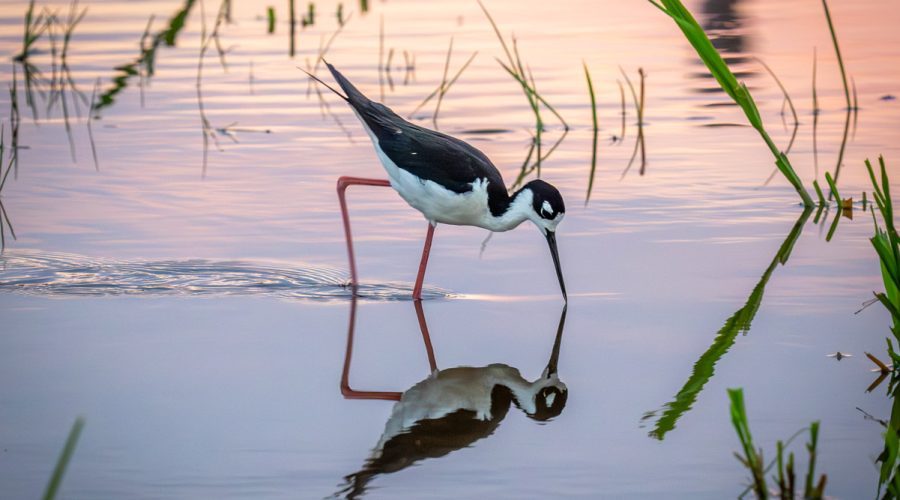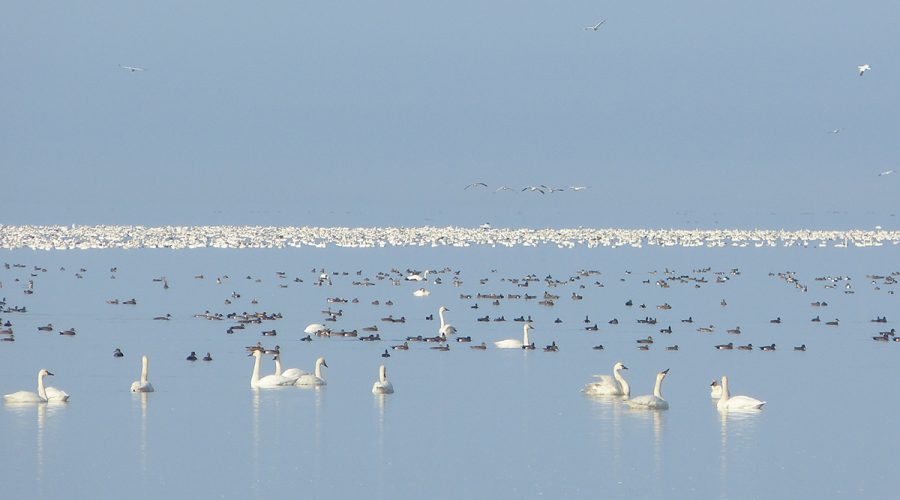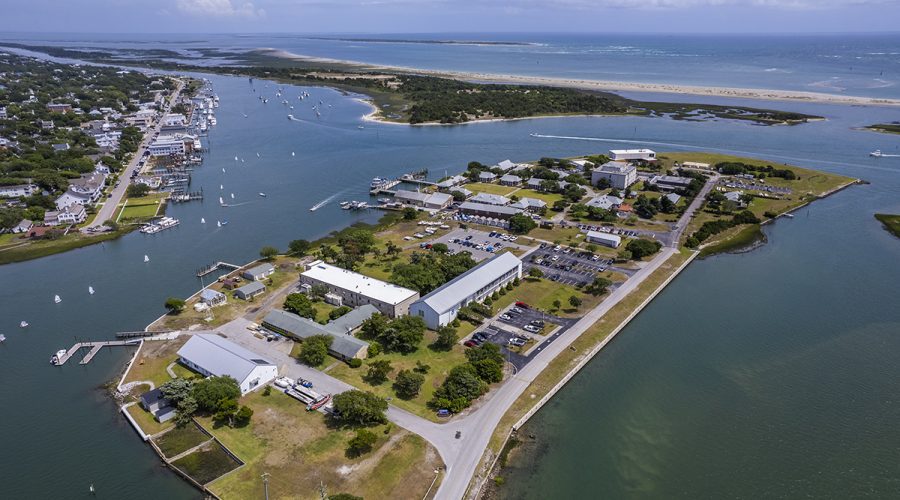Blaze, a piping plover shown here on the beach in Waukegan, Illinois, has returned for the second consecutive year to winter at Masonboro Inlet in New Hanover County. The small, but determined piping plover was abandoned before she hatched and became among the first captive-reared chicks to be released from the University of Michigan Biological Station in 2023. Within about two months of her release into the wild, Blaze migrated south to spend the winter at Masonboro Inlet, according to Audubon North Carolina. Audubon officials spotted Blaze Aug. 15 at the inlet, returning from Waukegan, where she successfully raised three chicks. Photo courtesy of the Lake County (Illinois) Audubon Society.
birds
Salt marsh snacks
A wedge of egrets fish in a salt marsh along North River near Beaufort. Photo: Dylan Ray
Bill for breakfast
A black-necked stilt dips its bill as it feeds in standing water at sunrise July 30 at the Oregon Inlet Fishing Center in Nags Head. Reader Brian Horsley of Nags Head submitted this image, noting that he captured the photo July 30 while on his way to work. When “it rains a lot and we get big freshwater puddles Black Neck Stilts pay it a visit,” he said with the submission.
St. James folk bask among beauty, birds certification brings
The town of St. James in Brunswick County recently became the only coastal town to become a Certified Community Wildlife Habitat, a relatively easy-to-get distinction through a National Wildlife Foundation program.
Groups seek to block Mattamuskeet algaecide treatment
The Southern Environmental Law Center, on behalf of Defenders of Wildlife and the Sierra Club, citing the threat to migratory birds, has filed a challenge in federal court to block the U.S. Fish and Wildlife Service from allowing an experimental algaecide treatment of Lake Mattamuskeet.
State issues certificate for Lake Mattamuskeet treatment
The North Carolina Department of Environmental Quality said Thursday its Division of Water Resources had approved a certificate of coverage to allow BlueGreen Water Technologies to conduct a pilot study of a treatment for cyanobacteria within a limited area of the state’s largest freshwater lake starting June 1.
‘R’ you ready for April?
A mallard strikes a semaphore-like pose signaling the letter “R” as viewed over the weekend from the dike at the Roanoke Island Marshes Dedicated Nature Preserve. Covering almost 1,900 acres of marsh and wetlands, the preserve is possibly the least well-known of the protected natural areas on the Outer Banks. Although most of the preserve is impenetrable, a 1.3-mile trail along an impoundment is, at times, a birder’s delight. Photo: Kip Tabb
Where war looks lost, Mother Nature fights climate change
Alligator River National Wildlife Refuge and other, nearby refuges and state lands especially vulnerable to climate change are getting $27.5 million from the Inflation Reduction Act for nature-based solutions.
Surf snack
A ruddy turnstone secures a snack recently at the surf’s edge near Oceanana Pier in Atlantic Beach. These sandpipers have a varied diet that includes crabs, mollusks, worms, sea urchins and small fish, according to the National Audubon Society. They nest in the North American and Eurasian arctic and winter along the coastlines of six continents. Contributed photo: Nicholas Green
Pelican’s perch
A pelican stretches while perched upon a pylon in Core Sound near the Down East village of Atlantic. Photo: Dylan Ray
First Lady Cooper plants tree at park to hail native plants
North Carolina First Lady Kristin Cooper and other state officials visited Jockey’s Ridge State Park last week to plant a persimmon tree and celebrate plant species native to the region.
Morning hunt
A blue heron hunts in the marsh grass near Conch’s Point on Calico Creek in Morehead City. Photo: Dylan Ray
Wings Over Water Festival set to mark 25th anniversary
The festival takes place at six national wildlife refuges that together cover parts of six northeast North Carolina counties and is the annual fundraiser for the Coastal Wildlife Refuge Society.
Petrels ‘little superheroes’ to researcher Kate Sutherland
UNCW researcher and Hatteras Island resident Kate Sutherland studies the chemical isotopes of the feathers from black-capped petrels, a difficult-to-study, endangered pelagic birds species.
Red knots make Outer Banks stopover on spring migration
Red knots, which stopover on Ocracoke during their spring migration, have been a source of concern due to the rapid decline of its population linked to a drastic decrease of their food source, horseshoe crab eggs.
Day on the water
Boats dot the Carteret County waters of, from left, Gallants Channel, Taylors Creek and Bulkhead Channel Thursday, with, in the foreground, Pivers Island, home to the National Oceanic and Atmospheric Administration Beaufort Laboratory and the Duke University Marine Lab; Front Street in Beaufort at top left; the Rachel Carson Reserve, center-left; Shackleford Banks, top-center and part of the Cape Lookout National Seashore; and the Atlantic Ocean beyond. Photo: Dylan Ray


















